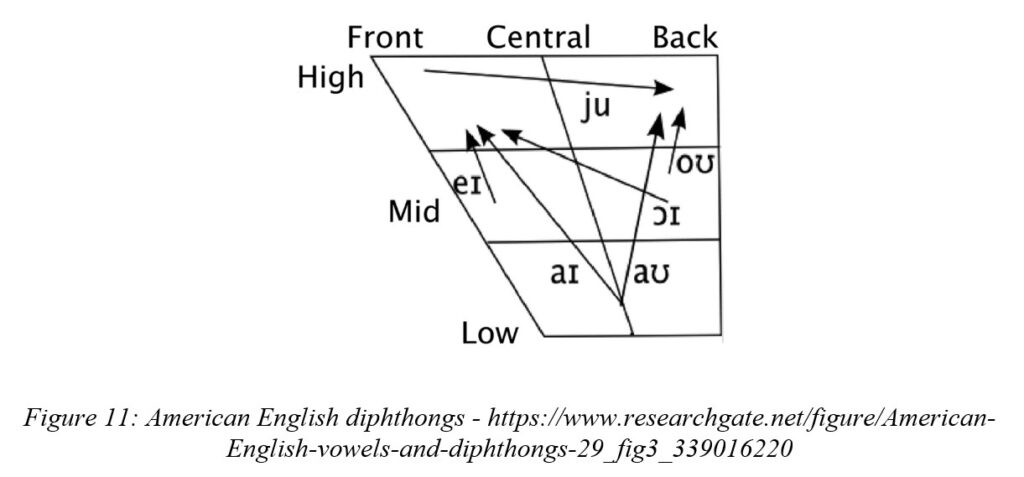PHONETICS AND PHONOLOGY
Segmental Aspects
AMERICAN ENGLISH DIPHTHONGS
American English diphthongs: eɪ aɪ ͻɪ oʊ aʊ jʊ
Cambridge English Pronouncing Dictionary (Jones, 2003) defines American English monophthongs as either lax or tense vowels and the American diphthongs as wide lax vowels which are “lower and made with less oral tension, they do not usually end syllables” (Jones, 2003, p. ix). Because of the fact that “the diphthongal movement in /eɪ/ and /oʊ/ is small“ (ibid.), these vowel combinations are classified as tense vowels (e.g. Jones, 2003). Other sources define them as diphthongs and, what is interesting, even /ju:/ is considered a diphthong (e.g. Tottie, 2002). The RP diphthong /əʊ/ is not pronounced in American English, and instead, there is /oʊ/ in American English. This diphthong is pronounced “with a more back and rounded starting point” (Tottie, 2002, p. 18).
British English centring diphthongs (ending in /ə/) are not pronounced in American English because American English is a rhotic variety. In rhotic accents, the final schwa is substituted by the retroflex approximant [ɻ]. British /ju:/ is pronounced as /u:/ in the American variety, e.g. duty /dju:ti/ vs /du:ti/.
Different sets of symbols are used as transcription symbols for the American vowel phonemes:
American English lax vowels: Ʌ e ɪ ʊ ə æ
American English tense vowels: ɑ: i: ͻ: u: ɜ: eɪ oʊ
American English wide diphthongs: aʊ aɪ ͻɪ
Retroflexed vowels (“r-coloured”) ɚ ɝ
(Jones, 2003, p. x):
Other sources, such as Tottie (2002), https://www.ling.upenn.edu/~rnoyer/courses/230/Ling230TranscriptionOfEnglish.pdf or https://rachelsenglish.com/
present the American English Phonemic Inventory as follows and seen in Figure 11:

American English diphthongs: eɪ aɪ ɔɪ oʊ aʊ ju
- /eɪ/ – the two adjacent vowels, /e/ and /ɪ/ occur together within one syllable, but the first of them is pronounced only in this diphthong. It does not correspond to any American monophthong (the American English monophthong is /ɛ/, not /e/). The sound /e/ is a wide vowel pronounced with the tongue pushed forward and pressed behind the bottom front teeth. The second segment is a front high /ɪ/-vowel.
- /aɪ/ – the first segment does not correspond to any American monophthong (to mark the quality appropriately, American monophthongs are transcribed as /Ʌ/ or /ɑ/); it is only pronounced in diphthongs. As it is being pronounced, the back of the tongue raises towards the soft palate, the upper lip pulls up and the tip of the tongue lightly touches the bottom front teeth. The tongue then glides rapidly to /ɪ/, the mid part of the tongue raises towards the hard palate. It makes a contact with the bottom front teeth.
- /ͻɪ/ – at the beginning of its pronunciation, the tongue and lips occupy the same position as for /ɔ:/, but /ɔ/ is shorter, more lax and more rounded than its counterpart monophthong pronounced on its own. Then the tongue glides rapidly to /ɪ/ coming forward and making a contact with the bottom front teeth.
- /oʊ/ – the vowel /o/ is a close mid back short lax rounded sound, this phoneme only occurs in this diphthong. The lips are rounded for /o/ more than for /ͻ/. The tongue rapidly raises up towards the soft palate and shifts back, the tip of the tongue does not touch any place in the oral cavity. Subsequently, it proceeds to /ʊ/. The lips are rounded for both sounds, but after all, /ʊ/ is more rounded than /o/.
- /aʊ/ – the first segment does not correspond to any American monophthong; it is only pronounced in diphthongs. To pronounce it, the tongue stretches towards the soft palate, the upper lip pulls up. The second segment is a rounded /ʊ/-
- /ju/ – its starting position is that of the letter consonant y pronounced as /j/, but acting as a vowel. According to https://rachelsenglish.com/, for instance in the word music, /j/ creates a diphthong functioning as one unit with /u/, it does not form a consonant cluster with the previous /m/. When /j/ is being pronounced, the lower jaw drops, the lips begin rounding for /u/, the tip of the tongue is down, slightly touching the bottom front teeth and the mid part of the tongue goes up and touches the hard palate, the vocal folds are closed. Then the tongue is released at the same time as the vocals and the vowel /u/ is attached.
(https://rachelsenglish.com/, https://www.webpgomez.com/english/407-pronunciation-of-american-english-diphthongs)

